Abstract
The survival and growth of toxigenic Vibrio cholerae 01 in water under various conditions of salinity, pH, temperature and cation composition and concentration were studied in an extensive series of laboratory experiments. Inter- and intra-strain variation in stress response (of 01 and non-01 strains) and the ability of V. cholerae to adapt to stressful environments were also studied. Toxigenic V. cholerae 01 were able to survive for at least 70 days at 25 degrees C in solutions of sea salt. The optimal salt concentration was 2.0% though all solutions in the range 0.25-3.0% gave good support. Substrains with enhanced capacity to persist at sub-optimal salinity (0.1%) were demonstrated. A great degree of inter-strain variation in stress response at low salinity (0.05%) was found among 59 strains, and this variation was unrelated to serogroup (01 or non-01), source (clinical or environmental) or country of origin (Tanzania or Bangladesh). At optimal salinity, inter-strain variation was less and 18 out of 20 strains remained viable at high concentrations for at least 40 months at 25 degrees C. V. cholerae 01 could not survive beyond 45 days at 4 degrees C and optimal salinity, either with or without nutrients. The optimal pH range for survival at 25 degrees C was 7.0-8.5 at optimal salinity, and 7.5-9.0 at low salinity. V. cholerae 01 require Na+ for survival in the absence of nutrients, and for enhanced growth in their presence. The presence of Ca2+ or Mg2+, in addition to Na+, further enhanced survival. These, and other results reported in this paper, suggest that toxigenic V. cholerae 01 are able to survive for extended periods in warm water containing no nutrients but having a salinity of 0.25-3.0% and a pH of around 8.0. With added nutrients and under the same conditions, rapid growth is possible. The implications of these findings for the identification of putative aquatic reservoirs of V. cholerae 01, and for the epidemiology of cholera, are considerable.
Full text
PDF

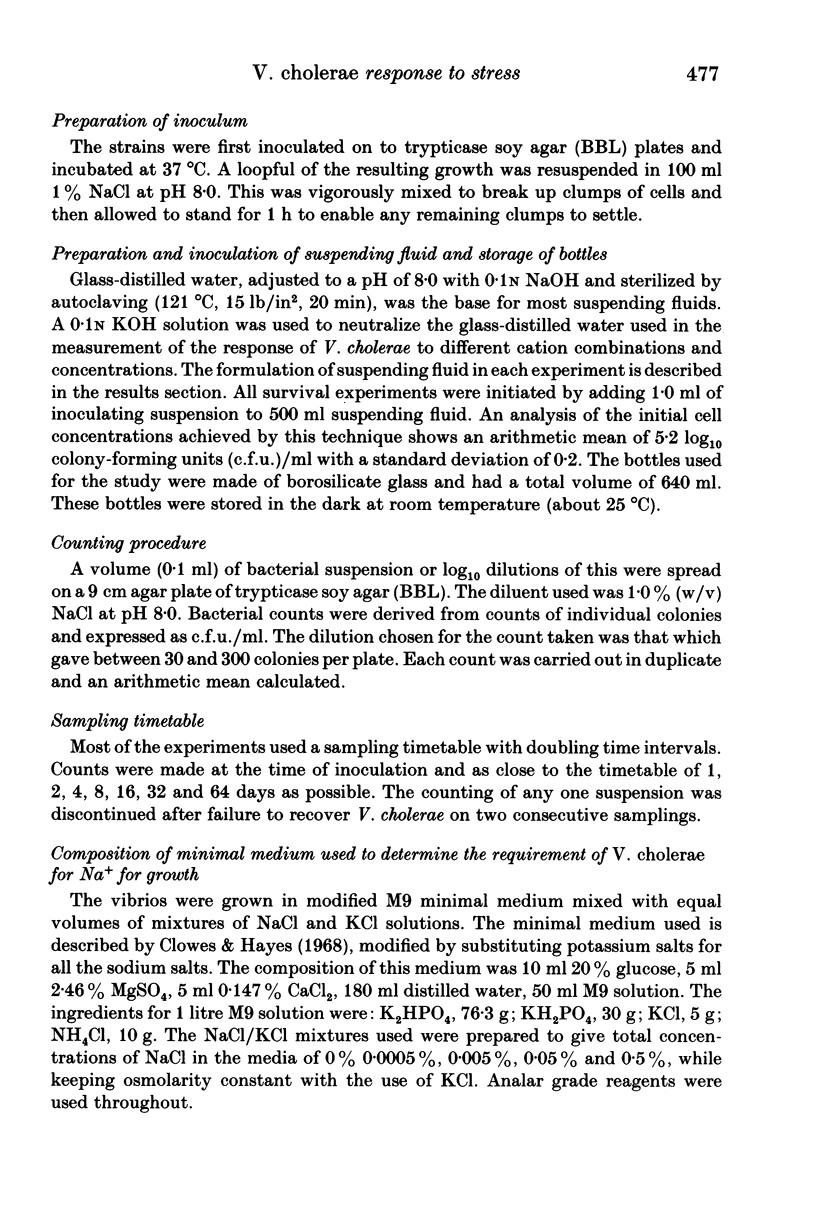
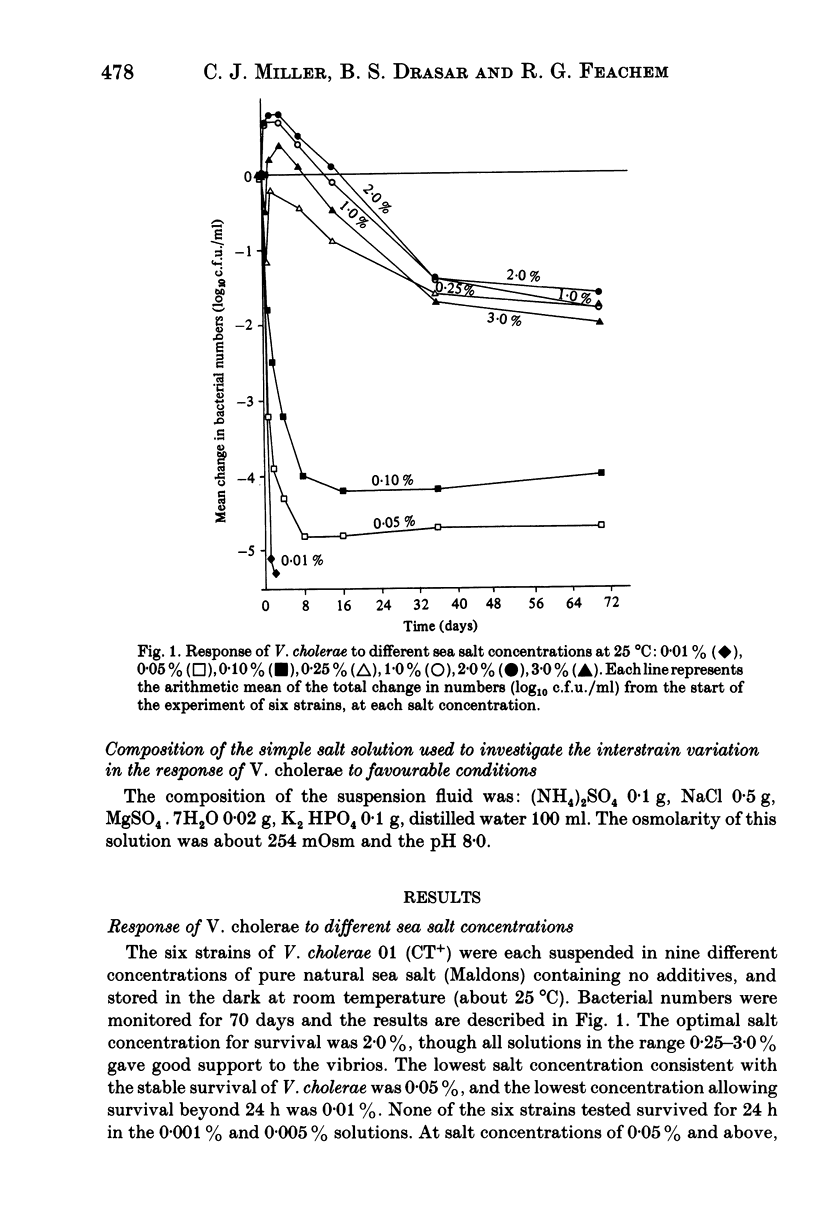
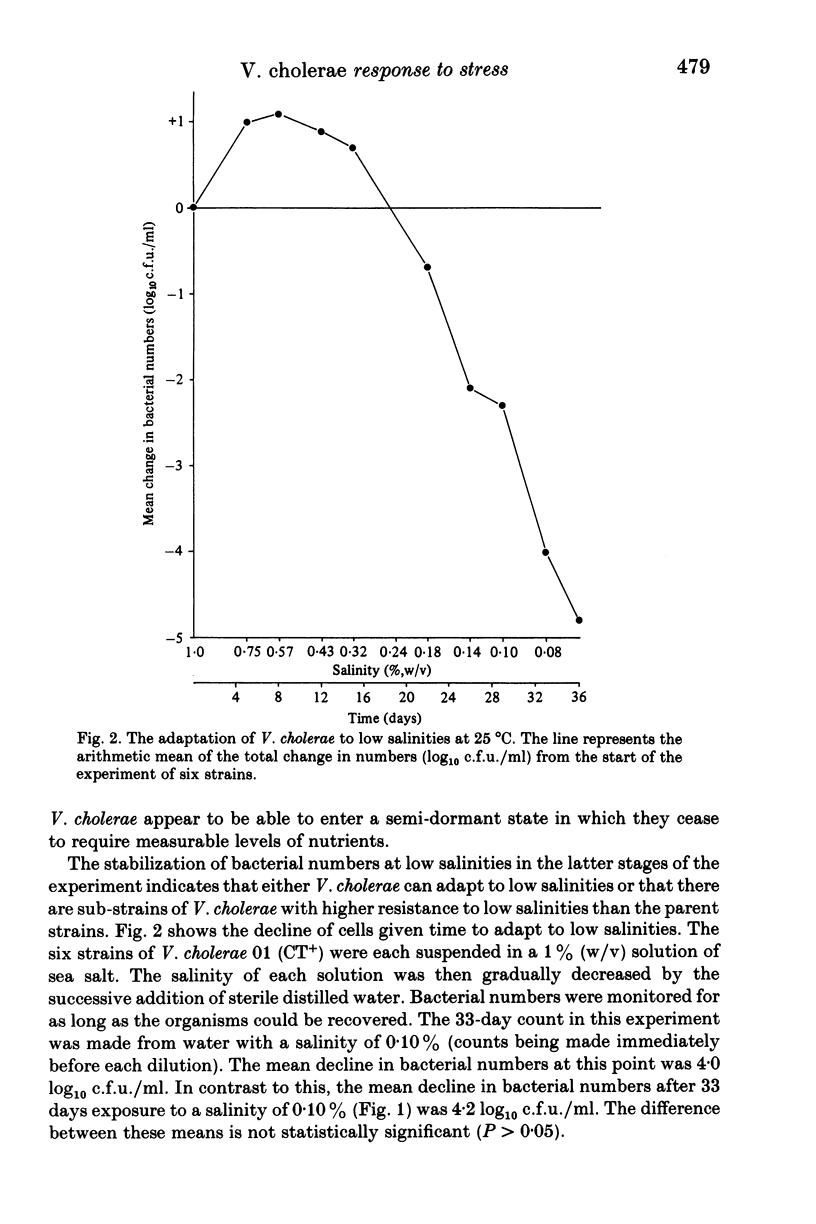
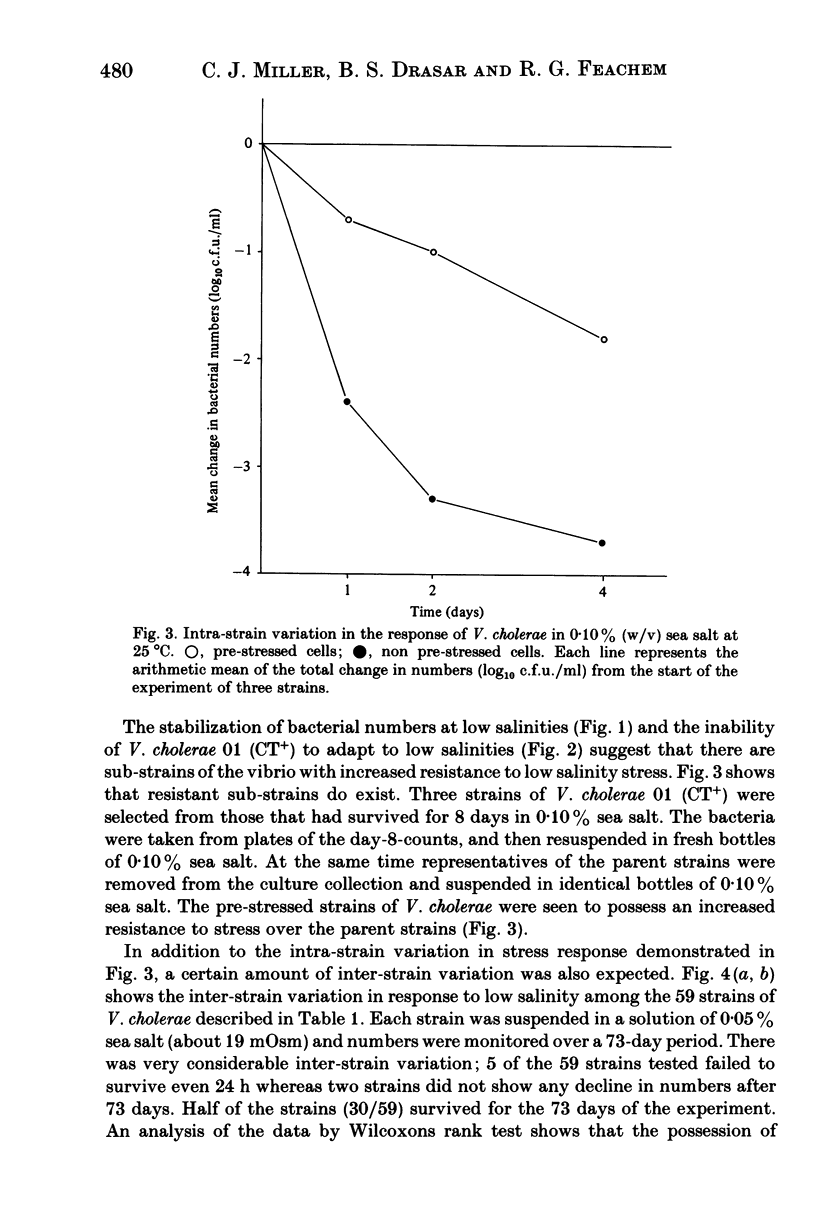



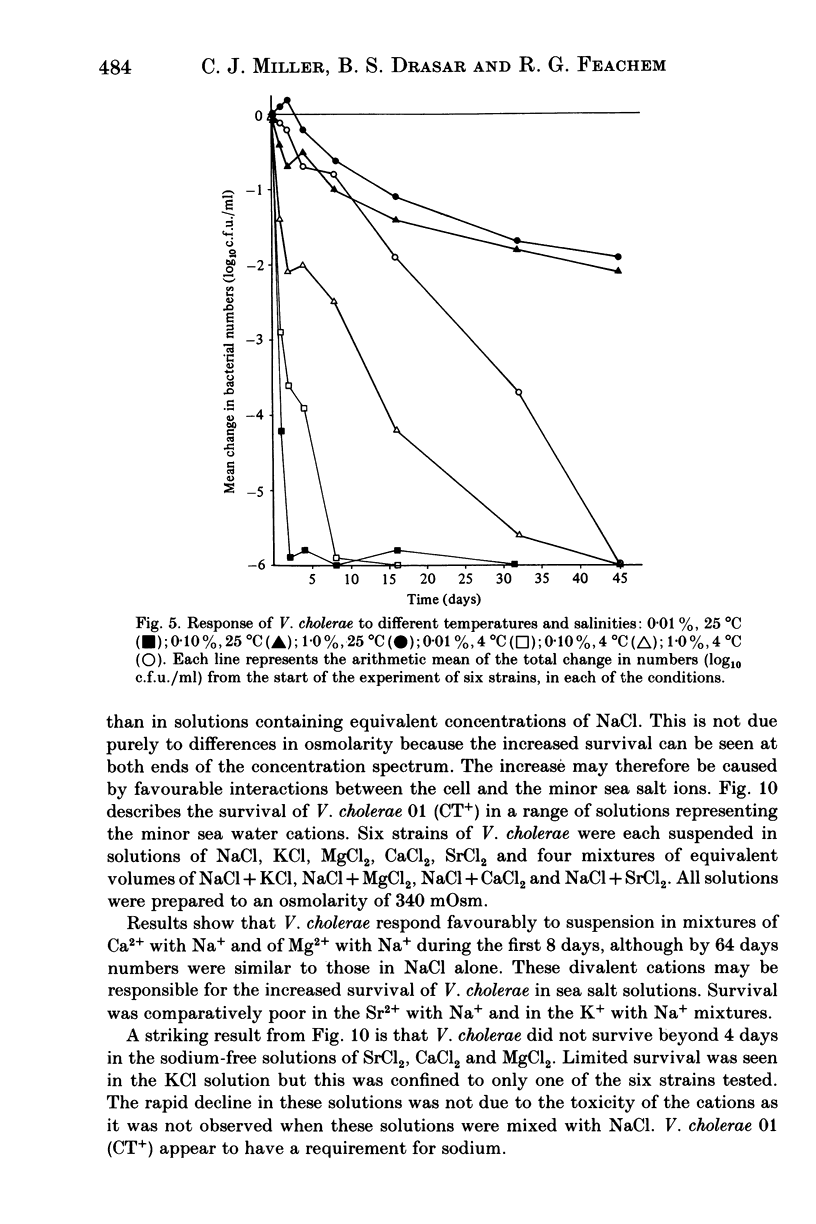


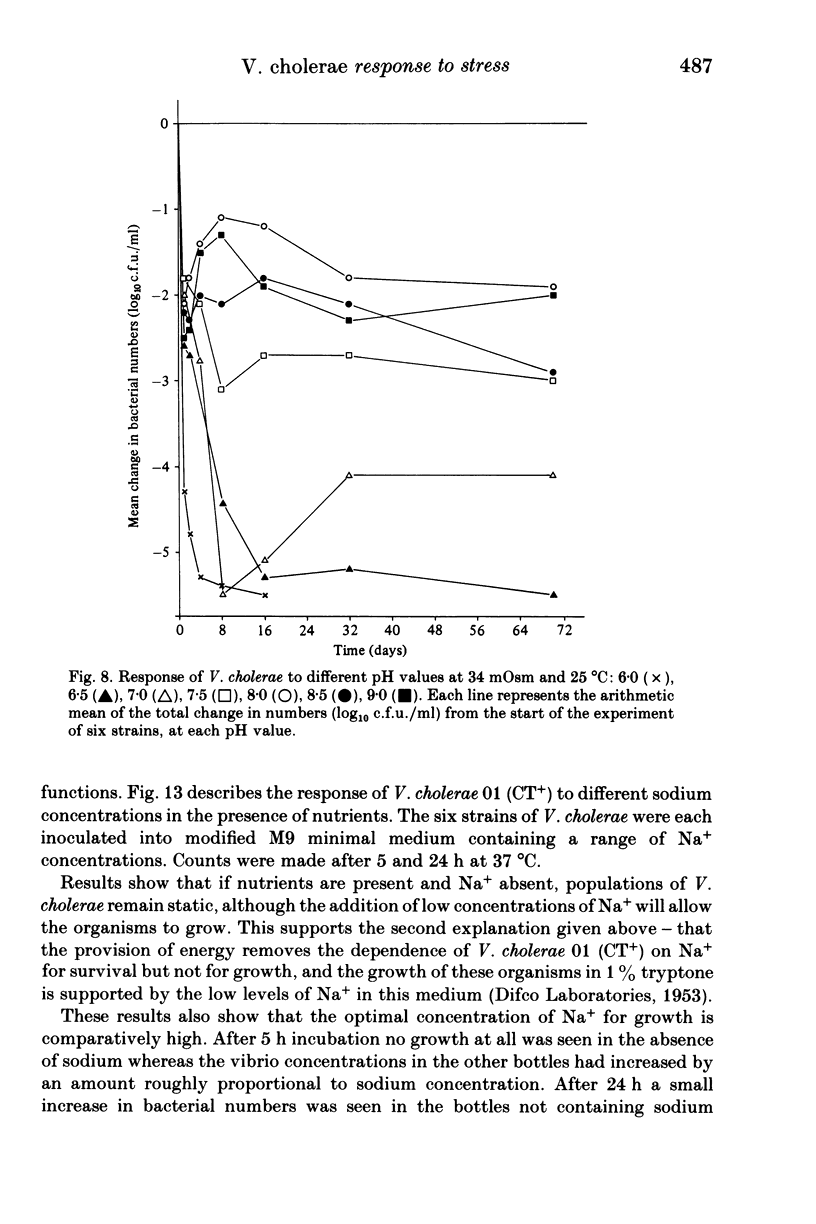


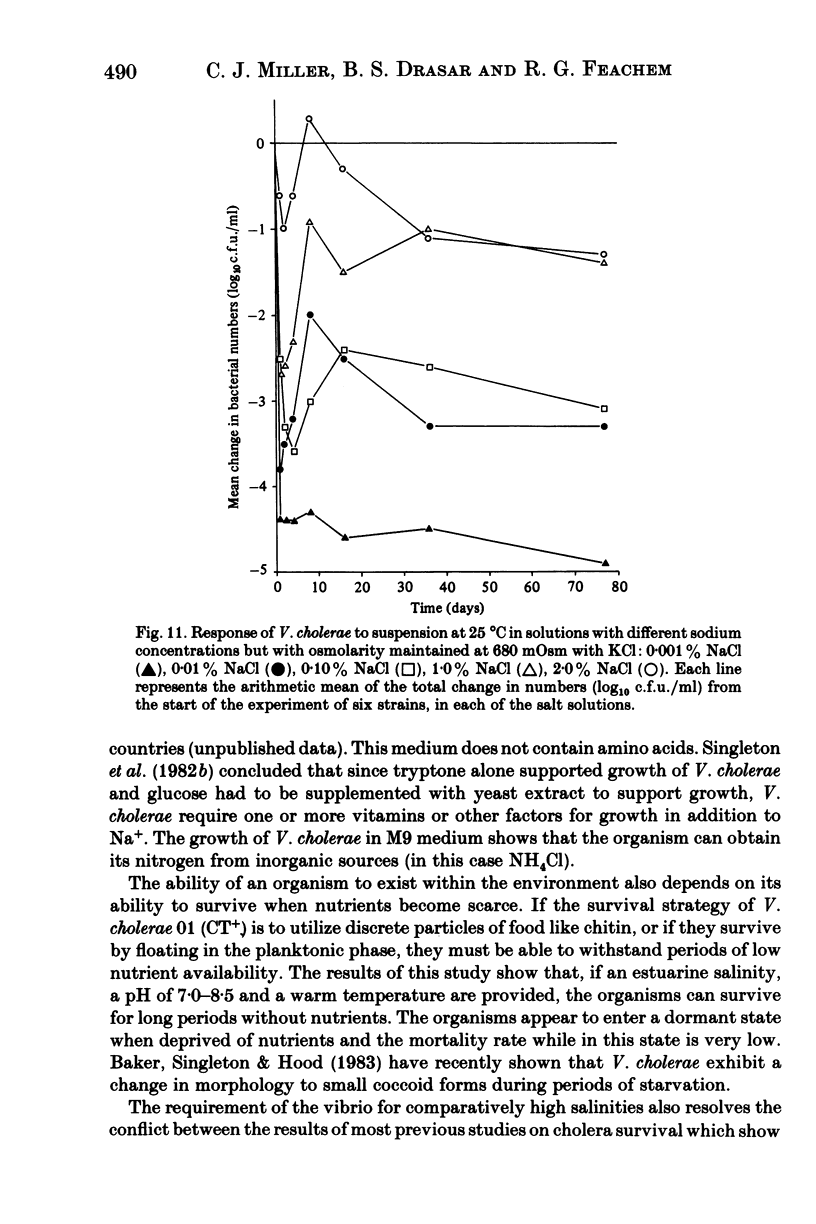





Selected References
These references are in PubMed. This may not be the complete list of references from this article.
- Azurin J. C., Kobari K., Barua D., Alvero M., Gomez C. Z., Dizon J. J., Nakano E. I., Suplido R., Ledesma L. A long-term carrier of cholera: cholera Dolores. Bull World Health Organ. 1967;37(5):745–749. [PMC free article] [PubMed] [Google Scholar]
- Baker R. M., Singleton F. L., Hood M. A. Effects of nutrient deprivation on Vibrio cholerae. Appl Environ Microbiol. 1983 Oct;46(4):930–940. doi: 10.1128/aem.46.4.930-940.1983. [DOI] [PMC free article] [PubMed] [Google Scholar]
- Bisgaard M., Sakazaki R., Shimada T. Prevalence of non-cholera vibrios in cavum nasi and pharynx of ducks. Acta Pathol Microbiol Scand B. 1978 Oct;86B(5):261–266. doi: 10.1111/j.1699-0463.1978.tb00042.x. [DOI] [PubMed] [Google Scholar]
- Blake P. A., Allegra D. T., Snyder J. D., Barrett T. J., McFarland L., Caraway C. T., Feeley J. C., Craig J. P., Lee J. V., Puhr N. D. Cholera--a possible endemic focus in the United States. N Engl J Med. 1980 Feb 7;302(6):305–309. doi: 10.1056/NEJM198002073020601. [DOI] [PubMed] [Google Scholar]
- Colwell R. R., Seidler R. J., Kaper J., Joseph S. W., Garges S., Lockman H., Maneval D., Bradford H., Roberts N., Remmers E. Occurrence of Vibrio cholerae serotype O1 in Maryland and Louisiana estuaries. Appl Environ Microbiol. 1981 Feb;41(2):555–558. doi: 10.1128/aem.41.2.555-558.1981. [DOI] [PMC free article] [PubMed] [Google Scholar]
- Hood M. A., Ness G. E. Survival of Vibrio cholerae and Escherichia coli in estuarine waters and sediments. Appl Environ Microbiol. 1982 Mar;43(3):578–584. doi: 10.1128/aem.43.3.578-584.1982. [DOI] [PMC free article] [PubMed] [Google Scholar]
- Hornick R. B., Music S. I., Wenzel R., Cash R., Libonati J. P., Snyder M. J., Woodward T. E. The Broad Street pump revisited: response of volunteers to ingested cholera vibrios. Bull N Y Acad Med. 1971 Oct;47(10):1181–1191. [PMC free article] [PubMed] [Google Scholar]
- Jannasch H. W. Competitive elimination of Enterobacteriaceae from seawater. Appl Microbiol. 1968 Oct;16(10):1616–1618. doi: 10.1128/am.16.10.1616-1618.1968. [DOI] [PMC free article] [PubMed] [Google Scholar]
- Kaper J. B., Moseley S. L., Falkow S. Molecular characterization of environmental and nontoxigenic strains of Vibrio cholerae. Infect Immun. 1981 May;32(2):661–667. doi: 10.1128/iai.32.2.661-667.1981. [DOI] [PMC free article] [PubMed] [Google Scholar]
- Kaper J., Lockman H., Colwell R. R., Joseph S. W. Ecology, serology, and enterotoxin production of Vibrio cholerae in Chesapeake Bay. Appl Environ Microbiol. 1979 Jan;37(1):91–103. doi: 10.1128/aem.37.1.91-103.1979. [DOI] [PMC free article] [PubMed] [Google Scholar]
- Lee J. V., Bashford D. J., Donovan T. J., Furniss A. L., West P. A. The incidence of Vibrio cholerae in water, animals and birds in Kent, England. J Appl Bacteriol. 1982 Apr;52(2):281–291. doi: 10.1111/j.1365-2672.1982.tb04852.x. [DOI] [PubMed] [Google Scholar]
- MACLEOD R. A. THE QUESTION OF THE EXISTENCE OF SPECIFIC MARINE BACTERIA. Bacteriol Rev. 1965 Mar;29:9–24. [PMC free article] [PubMed] [Google Scholar]
- Martin A. R., Mosley W. H., Sau B. B., Ahmed S., Huq I. Epidemiologic analysis of endemic cholera in urban East Pakistan, 1964-1966. Am J Epidemiol. 1969 May;89(5):572–582. doi: 10.1093/oxfordjournals.aje.a120970. [DOI] [PubMed] [Google Scholar]
- McCormack W. M., Mosley W. H., Fahimuddin M., Benenson A. S. Endemic cholera in rural East Pakistan. Am J Epidemiol. 1969 Apr;89(4):393–404. doi: 10.1093/oxfordjournals.aje.a120953. [DOI] [PubMed] [Google Scholar]
- Miller C. J., Drasar B. S., Feachem R. G. Cholera and estuarine salinity in Calcutta and London. Lancet. 1982 May 29;1(8283):1216–1218. doi: 10.1016/s0140-6736(82)92340-6. [DOI] [PubMed] [Google Scholar]
- Nalin D. R., Daya V., Reid A., Levine M. M., Cisneros L. Adsorption and growth of Vibrio cholerae on chitin. Infect Immun. 1979 Aug;25(2):768–770. doi: 10.1128/iai.25.2.768-770.1979. [DOI] [PMC free article] [PubMed] [Google Scholar]
- Pierce N. F., Banwell J. G., Gorbach S. L., Mitra R. C., Mondal A. Convalescent carriers of Vibrio cholerae. Detection and detailed investigation. Ann Intern Med. 1970 Mar;72(3):357–364. doi: 10.7326/0003-4819-72-3-357. [DOI] [PubMed] [Google Scholar]
- Rogers R. C., Cuffe R. G., Cossins Y. M., Murphy D. M., Bourke A. T. The Queensland cholera incident of 1977. 2. The epidemiological investigation. Bull World Health Organ. 1980;58(4):665–669. [PMC free article] [PubMed] [Google Scholar]
- Sack D. A., Huda S., Neogi P. K., Daniel R. R., Spira W. M. Microtiter ganglioside enzyme-linked immunosorbent assay for vibrio and Escherichia coli heat-labile enterotoxins and antitoxin. J Clin Microbiol. 1980 Jan;11(1):35–40. doi: 10.1128/jcm.11.1.35-40.1980. [DOI] [PMC free article] [PubMed] [Google Scholar]
- Sanyal S. C., Singh S. J., Tiwari I. C., Sen P. C., Marwah S. M., Hazarika U. R., Singh H., Shimada T., Sakazaki R. Role of household animals in maintenance of cholera infection in a community. J Infect Dis. 1974 Dec;130(6):575–579. doi: 10.1093/infdis/130.6.575. [DOI] [PubMed] [Google Scholar]
- Sarkar B. L., Nair G. B., Sircar B. K., Pal S. C. Incidence and level of Vibrio parahaemolyticus associated with freshwater plankton. Appl Environ Microbiol. 1983 Jul;46(1):288–290. doi: 10.1128/aem.46.1.288-290.1983. [DOI] [PMC free article] [PubMed] [Google Scholar]
- Singleton F. L., Attwell R. W., Jangi M. S., Colwell R. R. Influence of salinity and organic nutrient concentration on survival and growth of Vibrio cholerae in aquatic microcosms. Appl Environ Microbiol. 1982 May;43(5):1080–1085. doi: 10.1128/aem.43.5.1080-1085.1982. [DOI] [PMC free article] [PubMed] [Google Scholar]
- Singleton F. L., Attwell R., Jangi S., Colwell R. R. Effects of temperature and salinity on Vibrio cholerae growth. Appl Environ Microbiol. 1982 Nov;44(5):1047–1058. doi: 10.1128/aem.44.5.1047-1058.1982. [DOI] [PMC free article] [PubMed] [Google Scholar]
- Speirs J. I., Stavric S., Konowalchuk J. Assay of Escherichia coli heat-labile enterotoxin with vero cells. Infect Immun. 1977 May;16(2):617–622. doi: 10.1128/iai.16.2.617-622.1977. [DOI] [PMC free article] [PubMed] [Google Scholar]


